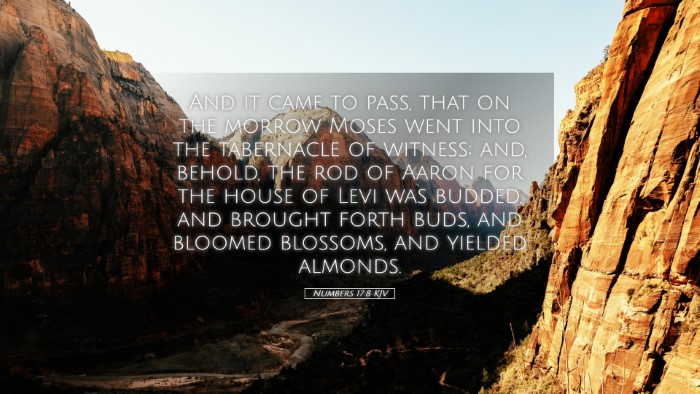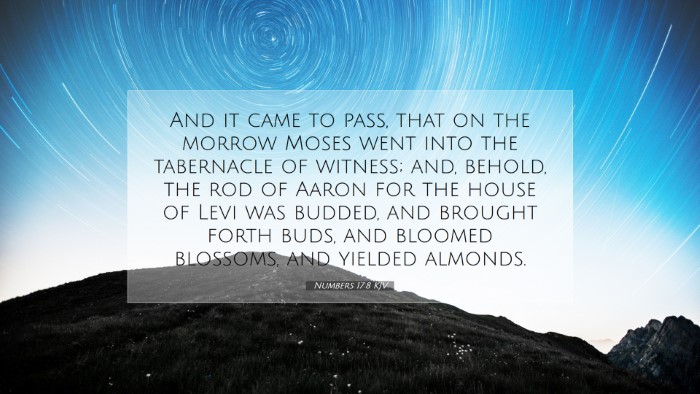Bible Commentary on Numbers 17:8
The verse Numbers 17:8 states:
"And it came to pass, that on the morrow Moses went into the tabernacle of witness; and, behold, the rod of Aaron for the house of Levi was budded, and brought forth buds, and bloomed blossoms, and yielded almonds."
Introduction
This verse marks a pivotal moment in the biblical narrative, illustrating God's affirmation of Aaron's priestly authority against the backdrop of rebellion and discord among the Israelites. This commentary draws from esteemed public domain sources to unpack the theological and practical implications of this event.
Contextual Background
The context of Numbers 17 lies in the wider narrative of the Israelites' journey in the wilderness, during which challenges to Moses' and Aaron's leadership arise. The previous chapters detail the challenges faced from the Korah rebellion, where the legitimacy of the Levitical priesthood was questioned. In response, God instituted a divine test to affirm His chosen leaders.
Significance of the Rod
In the ancient Near Eastern context, a rod was a symbol of authority and leadership. The choice of Aaron's rod serves to highlight God's selection of Aaron as the high priest and the implications of priestly service.
Analysis of Key Elements
-
The Tabernacle of Witness:
The term "Tabernacle of Witness" signifies a place where God's presence dwelt and where His acts were testified. It emphasizes the transition from human doubt to divine affirmation.
-
Budded Rod:
The budding of Aaron's rod is a miraculous sign that transcends the natural order. Matthew Henry comments on how this event serves as a divine endorsement, transforming a dead stick into a vibrant symbol of life and authority.
-
Symbolism of Blossoms and Almonds:
Almonds are often associated with vigilance and awakening. This is beautifully illustrated in Adam Clarke’s commentary, which notes that the early flowering of the almond tree symbolizes God's readiness to act swiftly in affirming His chosen leaders, reflecting His providence and watchfulness over His people.
Theological Implications
This passage brings forth essential theological truths that resonate through the biblical narrative:
-
Divine Election:
God’s choice of Aaron as high priest is reinforced through this miraculous sign, underscoring the theme of divine election found throughout Scripture.
-
Validation of Leadership:
Albert Barnes emphasizes that God validates spiritual leadership, especially in times of strife. Leaders in the church today can draw encouragement from God's affirmation of Aaron’s leadership amidst challenges.
-
New Life from Death:
The transformation of Aaron's dead rod into one that blooms illustrates the redemptive power of God in the midst of hopelessness, a theme echoed in the resurrection narrative.
Lessons for the Contemporary Church
There are several lessons for pastors, theologians, and students of Scripture:
-
Trust in God’s Leadership:
In the face of challenges and questions of authority, the church is called to trust in God's appointed leaders, recognizing that He establishes and confirms His servants.
-
The Role of Affirmation:
Just as God provided clear signs of leadership, churches today must ensure they are affirming and supporting those they believe God has called to lead.
-
Merit of Spiritual Symbols:
The rod, though a simple object, becomes a profound symbol of faith, leadership, and divine choice. This encourages modern believers to value the sacredness and symbolism in their practices.
Conclusion
Numbers 17:8 stands as a testimony to God’s intervention in human affairs. The miraculous budding of Aaron's rod emphasizes God's sovereignty, the importance of legitimate spiritual authority, and the profound truth that God brings life to what was once lifeless. The significance of this passage encourages believers to embrace divine authority and validation in their lives, fostering a renewed understanding of leadership within the community of faith.


